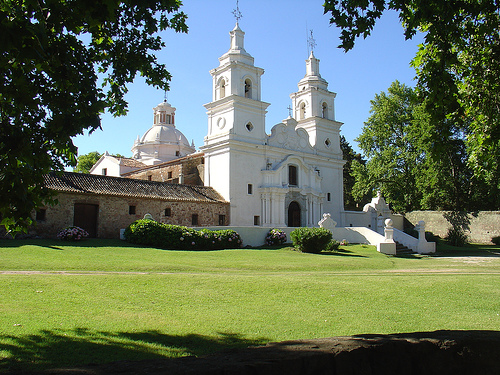

Location: 13 mi (20 km) North of Jesus Maria, Córdoba
Tel. (03525) 421 600
Open:
Jan- Feb 10am- 1pm & 3pm- 5pm Tue- Sun
Mar- Dec 10am- 1pm & 2pm- 6pm Tue- Sun
Service: Apr- Sep 10am- 1pm Tue- Sun
Oct- Mar 10am- 1pm & 3pm- 7pm Tue- Sun
Santa Catalina is a beautiful Roman Catholic Church of the Jesuit order and situated 13 mi (20 km) North of Jesus Maria in the province of Córdoba in Argentina. Santa Catalina was originally found in 1622 by Jesuits who came here to baptize locals and spread literacy among local indigenous tribes. One of the first things Jesuits did however was not the Baroque church you see today. Their first major project was hydraulic engineering that allowed tons of water to be delivered to the surface. Until that time local people did not have an access to reliable sources of water. New technologies brought by the brothers of the order changed all that. The area became famous as a breeding ground for thousands of cattle, mules, sheep and other farm animals. The church itself was completed only in 1754. It included an adjacent complex with orchards, workshops, cloisters enclosing patios, stables and many others. In 1941 Santa Catalina was declared a National Historic Museum. This religious complex holds its festivities devoted to their patron Saint Catalina on November 25th and last Sunday of January.
The climate is cold and dry with large temperature fluctuations between day and night and little rainfall in summer.
Santa Catalina is one of those Puna mining towns in Jujuy that arose in the 17th century and gained some importance. On September 8, 1752, the town received its own parish, independent of that in Cochinoca, to which it belonged until then. The chapels of Rinconada and Talna also belonged to the parish area.
Old church from the 17th century, with art from
colonial imagery. It is in front of the main square, next to the old
Saravia family building, forming an architectural complex. The 10 m
tower has three telescopic floors, with the same width as the nave (10
m), built above the lintel. The atrium, contained in the tower, follows
a 32 m nave, whose old altars were replaced by others from the 20th
century.
Santa Catalina is also known for the production of artisan
cheeses.
Church of Santa Catalina (Plaza). Together with the
house of the Saravia family, the 17th-century church forms an
architectural ensemble. The three-story, telescoping spire rises above
the front door and is ten meters wide, the same width as the church. The
porch of the church is located under the tower and opens at the back to
the 30 meter long nave. The old altars of the church have been replaced
with new ones.
Museo Regional Particular Epiphanio Saravia. The
museum is housed in the oldest house in town. It belonged to Laureano
Saravia, an important provincial politician at the end of the 19th
century. A collection of regional objects from the life of the Spanish
colonizers and the indigenous people is displayed in six rooms, such as
old weapons, spearheads, scales, clothing, musical instruments,
furniture and gaucho accessories. In the Casa de Cultura next door, the
collection is supplemented in four rooms with ceramics, photographs and
religious art.
Biblioteca Popular de Santa Catalina. The highest
library in Argentina with a literary treasure of around 7000 works was
founded 130 years ago.
Festivals
Virgen de Chinchillas (August 15). The
highlight of the annual festival calendar with procession and
traditional music.
The seismicity of the Jujuy area is frequent and of
low intensity, and a seismic silence of medium to severe earthquakes
every 40 years.
1863 earthquake: although said catastrophic
geological activity has occurred since prehistoric times, the earthquake
of January 4, 1863 (159 years),3 marked an important milestone in the
history of seismic events in Jujuy, with 6.4 Richter. But nothing
changed by taking extreme care and/or restricting building codes.
1948 earthquake: on August 25, 1848 (174 years) with 7.0 Richter, which
destroyed buildings and opened numerous cracks in huge areas.
2009
earthquake: November 6, 2009 (12 years) with 5.6 Richter
Santa Catalina is a former gold mining town. Even today, gold can be washed in the river in small quantities that cannot be used industrially. The main economic activity for the local residents has been the breeding of llamas, sheep and goats, which is mainly practiced today. Peaches, apples and plums are also grown.
Transport
Motorways
RP5, RP65, RP76
Road
distance:
to the administrative center of the province of San
Salvador de Jujuy - 331 km
to the nearest major city of La Chiaca -
62 km